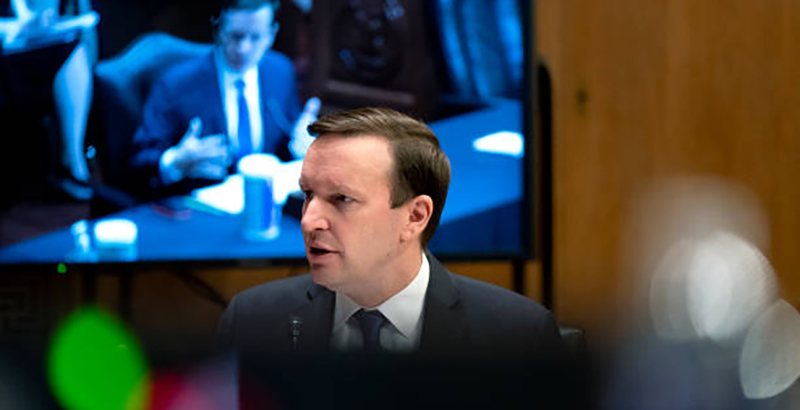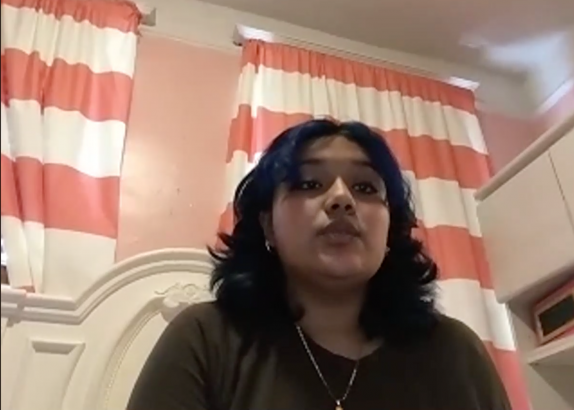74 Interview: Sen. Chris Murphy on Why He Wants to Ban Federal Funding for School Police, But Still Sees Some Campus Cops as an ‘Effective, Compassionate Presence’

Get essential education news and commentary delivered straight to your inbox. Sign up here for The 74’s daily newsletter.
Over the last several decades, the number of police stationed inside public schools has exploded, often with much fanfare in the wake of a mass school shooting. But that could soon change.
After a Minneapolis cop murdered George Floyd last year, dozens of districts nationwide did what student activists have been demanding for years and broke up with the police. Now, Democratic lawmakers aim to eliminate a mechanism that’s long encouraged educators to place police officers inside their buildings: A big pot of federal cash.
The Counseling Not Criminalization in Schools Act, reintroduced in June, would prohibit the government from using federal funds to hire, recruit or station police on K-12 campuses and instead creates a grant program providing billions of dollars for schools to hire support staff, like psychologists and social workers. It’s one of two bills being promoted this year by Sen. Chris Murphy, a Democrat from Connecticut, to disrupt the school-to-prison pipeline, a concept that highlights how harsh school discipline policies can push students, particularly youth of color, into the criminal justice system.
“We’ve got to draw the line, at the federal level at least, and say ‘From here on out, the money that the federal government spends should be spent on creating safe, productive school environments,” Murphy, who introduced the legislation, said during a recent press conference. “And that happens by investing in these kids through counseling, through nurses, through social workers, through psychologists, not through more police officers.”
In an exclusive interview with The 74, Murphy maintained that federal money would be better spent on student support services like counselors rather than paying officers to patrol hallways. Since the 2012 mass shooting at Sandy Hook Elementary School in Murphy’s home state, the senator has made gun control a central part of his political career. The tragedy also put a renewed focus on school policing, and though Murphy said he understands the perspectives of parents who believe their children are safer with cops on campus, “having a police officer in a school is not likely to stop a mass shooter,” he said.
Yet Murphy offered a more nuanced perspective on school-based police than the student activists and civil rights groups who have lauded his bill but demand police-free schools. Murphy said the debate over campus police should not be discussed in “absolutist terms,” adding that some school resource officers do a “great job,” and that communities should decide whether to keep them. He also supported the presence of campus security guards who lack arrest powers.
Youth activists, meanwhile, have been demanding for years that schools become entirely police-free and have argued that security guards contribute to a negative campus climate where students of color feel like they’re constantly under a microscope. Among them is Mariet Leana, a high school junior in New York City and youth activist with the groups Make the Road New York and the Urban Youth Collaborative.
“I have watched security guards repeatedly escalate altercations between students rather than diffuse them,” Leana said during the recent press conference to promote Murphy’s bill. “I have witnessed young people lose their hope and feel like schools are no longer safe places for them because of an overwhelming number of police officers and so few counselors, therapists and other support services that students need to thrive.”

In the last two decades, the federal government has spent more than $1 billion to hire additional school-based police despite inconclusive evidence that they make schools safer and could actually do more harm than good. In the 1970s, just 1 percent of schools had police stationed on campus. Today, that figure has jumped to roughly half.
As Floyd’s murder sparked nationwide protests about officers’ use of force, particularly against Black Americans, it elevated the conversation about the stark and persistent racial disparities in school-based arrests. Black boys are nearly 2.5 times more likely to be arrested at school than their white male classmates, according to a Georgetown University analysis of the most recent federal civil rights data. The racial disparity is even starker for girls. Black girls were more than 3.5 times more likely to face arrest at school than were white girls.
Nationally, 14 million students attend schools that have a campus police officer but lack a counselor, nurse, psychologist or social worker, according to an American Civil Liberties Union analysis. Though the American School Counselor Association recommends a counselor to student ratio of 250 to 1, it’s a benchmark that the public school system has long failed to meet. While schools have moved closer to reaching that goal in recent years, each school counselor in the U.S. serves roughly 430 students on average.
Meanwhile in May, Murphy reintroduced the Keeping All Students Safe Act, legislation that’s part of a yearslong effort to prohibit schools from using seclusion and restraint on students.
During the 2017-18 school year, districts nationwide reported using seclusion or physical restraint nearly 102,000 times, according to the most recent federal data, though that tally is likely an undercount. The practices are used disproportionately on children with disabilities and students of color and often have deleterious effects including injury and, in rare cases, death.
Murphy’s legislation would prohibit school officials and police from using physical restraint techniques that restrict breathing or limit blood flow to the brain, such as the face-down prone restraint, but it falls short of creating an outright ban. Certain forms of student restraint would still be allowed in emergency situations — a carveout that could be open to interpretation. While Murphy said that physical restraint could be necessary in “limited instances,” some advocates, particularly those who represent children with disabilities, say the practice should never be tolerated.
While both of Murphy’s bills were previously introduced in Washington but failed to catch on, several factors suggest that things could be different this time around. Along with Democratic control of the White House and Congress, the “police-free schools” movement gained steam after Floyd’s murder. The conversation with Murphy was lightly edited for length and clarity.
The 74: Both the Keeping All Students Safe Act and the Counseling Not Criminalization in Schools Act have been introduced in the past. What is different this time around, and what needs to happen to get these bills to the president’s desk?
Murphy: It certainly helps to have an administration that understands the sort of complicated nuance around how we keep kids safe. In reality, loading schools up with police officers doesn’t end up keeping kids safe, it ends up with far too many kids being arrested for things that should be dealt with inside the school.
Restraining a kid or locking a kid up, you know, may be a short-term solution to diffusing a situation, but it ends up in all sorts of unacceptable long-term trauma that doesn’t help the kid or the school. So you know, we’ve got a president that I think cares about this topic and we now have a majority in the Senate that cares as well. Sen. [Patty] Murray [who chairs the Senate education committee] is a former school teacher, Sen. Murray is very plugged into this conversation and very willing to lead.
On a personal level, what motivates your interest in proposing these bills?
I have kids in the public schools. I’m married to a former educator who spent 10 years representing low-income children who were facing suspension and expulsion. I have a decent amount of firsthand experience with school systems that are overly punitive in their approach to student misbehavior. I’ve seen what doesn’t work, I’ve seen what works and I just think that, as a parent, I need to be a leader in trying to enact policies that protect kids rather than traumatize kids.
I also represent a state that has continuing, indefensible disparities between how kids of color are treated and how white kids are treated when it comes to restraint and seclusion and arrests. I have an obligation to address the ways in which even my state isn’t meeting the mark on the civil rights of kids.
Turning to your state here, the Obama administration did increase federal funding for school police after the Sandy Hook school shooting. What are your thoughts on the effects of that decision and how did it motivate your decision to try to reduce the presence of police in schools?
I don’t think there’s one uniform story when it comes to the efficacy of police in schools. I’ve talked to lots of students, parents, teachers, administrators, and I know there are schools in which police are an effective, compassionate presence. But I’ve also seen the data, and the data tells me that, overall, kids of color and disabled kids are treated differently when police are present in schools. Too many of them end up getting arrested for, you know, talking back to a teacher or engaging in pretty run-of-the-mill misbehavior.
So that’s why I’m not proposing to outlaw police in schools, I just think federal dollars should be used to prioritize hiring counselors and psychologists and let state and local dollars be used for police if that community really thinks that there’s no other way to keep their students safe.
Education Secretary Cardona did recently speak highly of school resource officers in his Connecticut district, adding that they can be a positive presence in schools if well trained. What is your response to his characterization about the efficacy of police in schools in Connecticut, and what work do you need to do to get him on board with your plan?
I don’t think you can talk about this issue in absolutist terms. There are some school resource officers who are doing a great job. There are some schools that may be well-served by police officers. I just think federal money would be better off spent on other resources to support kids.
I’ve talked about the broad subject with the secretary but I have not talked to him at length about this piece of legislation. So I don’t know his sort of specific views on it, I just ultimately think it would be better off for federal resources to be spent on other kinds of support services for kids.
Mass school shootings have long motivated efforts to increase the police presence in schools. What is your response to parents who demand heightened school security after such tragedies, and what efforts do you believe are more effective in maintaining safe schools?
I completely understand the reaction that happens in schools where parents feel like their kids will be better protected if there are police officers. I have kids in the public schools. My number one, two, three and four priority is that they are safe. But what I know from experience is that having a police officer in a school is not likely to stop a mass shooter, and given the infrequency of school shootings and the incredibly high volume of police in schools, the overall effect of police in schools tends to get kids arrested for stuff that shouldn’t end up with them in the criminal justice system instead of violence being abated.
I mean, what we need are programs that wrap services around kids at risk. What we need to do is identify really troubled kids early on, before they commit acts of violence, and seek to give them pathways back to health. I haven’t seen a lot of evidence that a police officer in a school is going to be the most effective way to stop a mass shooting.
But again I’ll say this, I think that’s up to every school district. As a parent, I don’t want police officers in my kids’ school. But I understand different parents will come to a different decision and that’s why I think it should be local dollars that support police in schools because different jurisdictions are going to make different decisions about whether they think it works to have police in their childrens’ school.
The president’s latest push to prevent gun violence included an announcement that federal pandemic recovery funding could be used to hire additional police. What is your perspective on his plan and how might it affect students?
I don’t think it’s a smart idea for federal dollars to be used to hire police in schools. I just think it’s a real nightmare for kids when the counselor to student ratio in this country is [out of whack]. Right now, what we’re missing in our schools are guidance counselors and social workers and school psychologists, not uniformed police officers.
Following George Floyd’s murder, school districts across the country severed their ties with the police. What promising alternatives have you seen that schools have adopted, and have you observed any negative effects that maybe need to be ironed out?
I think that there are instances where it makes sense to have school security. I think that what we need to start thinking about is a model where schools have the ability to hire security officers that are trained and professional but don’t come with the power to arrest.
It’s that power of arrest that often gets abused and often gets used to target students of color, so one of the models that I think is worthwhile in pursuing is a level of security professional that has the training necessary to give peace of mind to school superintendents and principals, but isn’t a uniformed police officer so you can’t have hallway fights turned into arrestable offenses.
Your legislation would ban restraint techniques that restrict breathing, such as the prone restraint used on George Floyd. Why does the legislation target these restraint tactics in particular and why are other forms of restraint still permitted in certain circumstances?
There are limited instances where a teacher or an administrator, as a last resort, has to put their hands on a child. If that child is completely unable to be controlled any other way and is presenting an immediate physical threat to those around them, it may be necessary for an administrator or a teacher to use some physical means to stop that child from hurting others.
What my legislation calls for is best practices to be put in place so as to have every school administrator and teacher trained in de-escalatory measures that view physical restraint as a last resort, but also the prohibition of certain restraints that do pose an immediate safety risk to the student. So there are some restraints, including those that restrict breathing, that should be off limits. But just as importantly, you should have in place protocols that guide adults to different de-escalatory tactics than putting their hands on kids.
ProPublica and the Chicago Tribune found that Illinois schools were putting children in seclusion rooms for reasons that violated a state law. How will you ensure that schools follow federal rules if signed into law?
If a state doesn’t comply with federal law, they could lose their federal funding and that requires very vigorous oversight from the Department of Education. Now, different administrations have different styles when it comes to enforcement of existing law, but my hope is that if we were to pass [the Keeping All Students Safe Act], the Biden administration would act forcefully to make sure that schools comply. If they don’t, they risk losing their federal funding.
Speaking of federal funding, schools across the country will see an uptick in federal money due to pandemic relief funding. How will these two bills, when taken together, help schools to develop less punitive discipline strategies.
Many schools will complain that they don’t have the staff resources to try to wrap services around certain children that present a risk of violent behavior, and there’s some truth to that complaint. My hope is that the American Rescue Plan dollars and the funding approved last year will, at least in the short run, help schools staff up appropriately so that they can meet the needs of some of their more troubled kids.
I don’t think, even with meager staff resources, it ever makes sense to lock a kid up in a closet. But I do recognize that it does necessitate additional funding to provide support services to kids who may be acting out in class, sometimes in violent ways. Hopefully the new federal funding streams at least over the next few years will help with that.
Get stories like these delivered straight to your inbox. Sign up for The 74 Newsletter

;)
